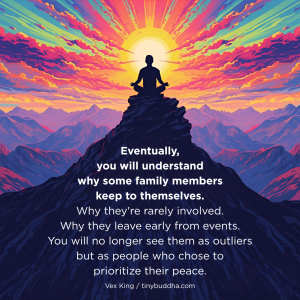
“Ships don’t sink because of the water around them; ships sink because of the water that gets in them. Don’t let what’s happening around you get inside you and weigh you down.” ~Unknown
Working in an office requires us to spend more time with our co-workers than anyone in our personal life. How those co-workers act can have a big impact on us. Noticing a co-worker’s interactions during a recent marketing job gave me insight into how I react in stressful or frustrating situations outside the office.
My cubicle sat next to a team of individuals who were required to be on the phone nearly every minute they were at their desks. It seemed unimaginable to me that a person could work this way day after day.
I could listen to their conversations as I worked, and was impressed with their finesse at handling difficult conversations, or tact when delivering unfavorable news to their clients on the other end of the phone. I sincerely admired their talents.
One particular day evoked a light-bulb moment for me. A young man named Dan was frustrated with the person he was speaking with on the phone. He stepped into the break room and unloaded his frustration loudly, with hand gestures, a flushed face, pacing, and a string of not-so-kind words.
I didn’t think anything of this type of behavior. To me, it seemed like a natural reaction. It was only after he left the room that I realized no one else saw the situation this way.
I listened to my friends talk about this young man’s behavior as unprofessional and imbalanced. It even caused them to question his worth as a team member. They expressed how this had happened in the past and how he obviously had some problems.
Wow. I knew I had behaved this same way many times in the past.
After that, I started noticing how I reacted to difficult situations. I realized that when my peers were complaining about work, management, co-workers, etc., I took on those feelings. I also could react similar to Dan did when I was frustrated with something I couldn’t control.
I could see it in my home life too. I realized that my reactions to small life occurrences were much more pronounced than my boyfriend’s. This caused friction.
For example, if my boyfriend made a comment about another woman, I would yell, slam doors, and exaggerate about how much the comment had hurt me.
My behavior made me look small and out of control to my mate. He said nothing after the first time, but after the twentieth time, he didn’t want to deal with it anymore.
Why did I blow things out of proportion? Looking back, I realize I was feeling vulnerable and scared when I behaved this way.
How could my responses be more in line with my mate, co-workers, and others? I knew what it was like to be around irritated, riled people, since that was my experience growing up. Not much fun. I didn’t want to be that person for anyone else.
It helped me to realize I’d been modeling the over-the-top reactions I’d witnessed during my early years. It’s what I’d been taught.
After asking my friends how they would have handled certain difficult situations, and tuning into myself, I found six techniques that help me react calmly. As a result of applying these ideas, I’m now leading a much happier life.
1. Train yourself to notice your physical feelings in stressful situations.
Notice when you start to feel clammy, fidgety, tight in the chest, outside of yourself, or any other physical discomfort. The more you practice noticing how you feel physically, after someone has said something upsetting, for example, the better you will be able to understand and alter your reactions.
In time, you will be better able to sense when something is emotionally affecting you by noticing the physical manifestations.
As you feel them, visualize the negative physical feelings running down your body and out your fingertips and toes.
For instance, your co-worker gets high praise for a project for which you provided key input. You receive nothing. You might notice your breath start to quicken and recognize that this physical reaction is a sign of defensiveness. You could then visualize your breath slowing and the defensiveness running down your body and out your toes.
2. Be aware of when people around you begin to get upset.
Once you’ve trained yourself to notice your physical feelings, look outwardly to how others react physically. Is your co-worker speaking more quickly, or does he maybe have a flushed face? Has she started to re-arrange items on her desk, or is she fidgeting in her chair?
As you become aware of physical behaviors that can signal agitation, dislike, etc., you can train yourself to leave that negative feeling with the person feeling that way.
That negative feeling is theirs. Let them have it. Don’t engage.
Visualize the negative feeling as a box, and leave it squarely on the other person’s lap. Think to yourself, “Let go,” then slowly blow out air while thinking, “gooooo.” This is an instant calming technique.
I eventually became able to use this “box” technique in my relationship with my boyfriend. If he’s upset with me, I now quickly assess whether I’ve been unkind, inconsiderate, judgmental, or whatever he’s accused me of being.
If I know I have, I own up to it right away and apologize. But if his accusation isn’t true, then I can see his it’s coming from how he’s feeling about himself. If that’s the case, I leave the box with him.
I try to to help him figure out how he’s feeling. I speak calmly and leave a lot of room for him to speak, so as to be a good listener. But I don’t take on his feelings as my own.
Remember their feelings are not your “box”—not your problem.
3. Spend plenty of time quiet and alone.
Another technique to calm how you react in difficult situations is to build up your bank of quiet, stress-free air. Visualize the air surrounding you when you’re calm, thinking positive thoughts. Give the calm air a color—pale blue, pink, or whatever.
Now, visualize the air going into a large bank. Test out different amounts of quiet time each week. Maybe for you, ten minutes a day fills up your bank. Maybe thirty minutes of quiet reflection each Saturday is enough to calm you throughout the week. Make it right for you.
For centuries monks, clergy, nuns, and lay people have practiced silence. When quiet, a person can reflect, re-charge, and center oneself. Each time you sit in silence, remember, you’re depositing more quiet, calm air into your serenity bank.
4. Commune with nature daily.
As you hear the quiet, notice the natural breeze and visualize it carrying away any heavy emotions that weigh you down. I guarantee you will start to feel physically lighter as the breeze blows your troubles away.
Researchers found a decrease in both heart rate and levels of cortisol in subjects in the forest when compared to those in the city (as reported in the Environmental Health and Preventative Medicine).
Take in nature through your pores so you can carry it with you to that boardroom, with fluorescent lights and stale air.
5. Journal about worries.
Journaling through any worries can diffuse negative thoughts. When worry is becoming prominent, first write down the concrete facts of the situation. What do I know for sure? Not what I think may be the case, just the facts. Can you see why this is upsetting to you? Next, write the worst possible outcome.
After seeing the worst-case scenario, walk through the solutions that are available to you. Have you ever been in a situation where you felt as helpless or worried? Remind yourself how you made it through that situation, and that you’ll find a solution for today’s worry too. If you don’t have time to write, use these same techniques in your thoughts.
6. Keep your muscles strong.
We’ve all heard that we release endorphins when we exercise. Let this be a reminder to consciously use these hormones when you need it.
I find it easier to work out when I think of the emotional benefit I’ll receive from the physical exercise.
For example, while practicing yoga or Pilates, the stretching, the slow muscle movement, the blood flow to large muscles as they work hard, all bring our thoughts to the present. Focusing on your body movement is a great way to let go of whatever is on your mind.
—
It may have taken me four decades to realize I reacted unfavorably because of my early home environment, but I’ll hopefully have four decades to practice a new way of reacting.
If we foster calm in our lives as much as we can, when a situation occurs, we will have the tools and techniques to react calmly and wisely.
About Debra Happe
Debra Happe is a marketing professional and writer based in Iowa. She is letting go daily, in order to live a more peaceful life. To read more by Debra, check out www.middleamericavoice.com or where ever she is writing at the moment.













 Though I run this site, it is not mine. It's ours. It's not about me. It's about us. Your stories and your wisdom are just as meaningful as mine.
Though I run this site, it is not mine. It's ours. It's not about me. It's about us. Your stories and your wisdom are just as meaningful as mine.
hi debra. i am new to tiny buddha and yours is the first post that i,ve read. its good.I personaly feel practicing little bit of detachment is also very helpful in staying calm in the midst of chaos.
It’s worth remembering that when people overreact , they may not be overreacting to something that you have said or done, but rather to something which has happened possibly as long ago as childhood, which has never been resolved.
I find that instead of focusing on what is causing the stress, one of the best forms of “medicine” is to look at it in a different light. That is, instead of focusing on what is wrong with a situation (stress causer), find out what is right (stress reliever) about it.
For example, an argument with a spouse. While tensions can get high, if you take a moment to think about what the positives of an argument can be (you learn a little bit more about them), the likelihood of it causing continuous stress dramatically drops.
After reflection it usually becomes very clear that there is good in every situation…sometimes it is just difficult to see.
Wonderful post!! It is amazing what we can learn when we become more in-tuned and aware of other’s behaviors that might be unfavorable and ask ourselves “do I do that?” Thank you for sharing your experience and wonderful tips and insight! # 2 is my fave, I agree that if there is no ownership to take, it is their’s to work through, you don’t have to carry their box. 🙂 NICE!!!
Brilliant…thnks
Nature and alone time are HUGE factors for myself. The serenity found in these moments never fail at allowing me to bring presence into any situation. The older I get the more I realize that as humans we are constantly communicating through energy and without presence the negative feelings of others can suck the life right out of us. Thanks tiny buddha! Great tips!
So I’m having trouble with my sister disappointing me I guess, I’ve always kinda saw her as the person who has been a role model for me when I was younger and now I’m confused on how I’m supposed to feel about my sister going out to parties and drinking alot , when I was about 8 years old my sister moved out of the house and she was there for me always since my my dad was always working and I was verbally abused by a family member and I haven’t been in much contact with her since she moved away but when I was eleven my dad lost his job so I had to move 150 miles away from her so contact completely stopped after that and just recently about 5 years later I got a phone and I’m able to see what she’s been doing on social media, and I just feel like my world is kinda tumbling down upon me I don’t wanna say anything to make her feel bad, I’ve been wondering what I should do and is it okay for me to feel this way
Thank you so much!! Your post is great! I really needed that.